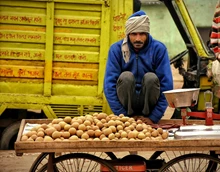
The development of US agricultural policy and considers how it has affected US consumers and producers, as well as how US programs affect foreign producers and consumers within the context of the United States’ obligations under the World Trade Organization. Throughout its history, the United States has supported the farm sector through a myriad of policies affecting prices, production, and farm incomes. Although many of the policies put in place during the New Deal legislation in the 1930s were seen as temporary at the time, most have persisted in one form or another to the present day.

Richard Pinkham, Director of Programs, North India Office, Embassy of the United States of America has organized a evening lecture by Dr Robert Johansson, Chief Economist, USDA, U S Embassy, New Delhi on the `Evolution of U S Agricultural Policy. The introduction to the speaker was given by Ms Jeanne Bailey and Dr R Johansson presented the power point presentation in 32 slides and exhaustive view of the United States Agriculture Policy.

First of all Dr Johansson gave away the Farm Bill Legislative Process to make the audience understand the basics of the Agriculture Policy of the United States. Dr Johansson described about the 2014 Farm Act giving details of the four titles dominated projected outlays also. The major emphasis of 80 percent was devoted to Nutrition, then comes the crop insurance with 8 percent and the conservation is 6 percent. The commodities with 5 percent and the rest is to 1 percent only. The total outlays are of $489 bill. In the context for US ag policy: Abundant Land... the grassland pasture and range is 29 percent just one percent increase to the forest use of 28 percent, then comes the crop land of 17 percent and 14 percent for the special uses. The rest is of 9 percent.

Dr Johansson further added that virtually all US farms still family owned, but vary widely by size and role in farm economy. Towards the income which most US farm holds comes from the market sources. Actually, the US Farms address many market and weather risks using private strategies and products. Basically American agriculture extends beyond field crops. The corn and soybeans are having 23 percent share whereas the other livestock with 24 percent and the fruits, vegetables and nursery crops only 17 percent.

The Dairy is having 16 percent and the other crops only 10 percent.
US Government programs increasingly enhance or supplement private risk management. The policy vision has evolved over time: Earliest policies focused on infrastructures. Policy reorientation to risk management responds to rising global demand and competitive markets. So with the improvement in the farm incomes the rural programs refocused on non-farm economic development. There is crop disaster assistance programs and livestock disaster assistance programs also. With crop insurance program, the fruits, nuts, and trees have steadly increased insurance coverage. Over the time, the agricultural conservation programs have been added. Towards the US India Agricultural trade, the US India Ag Bilateral Trade, there was an upward trend 2011, 2012 and then slight decrease in 2014 then also towards increasing from 2015, and 2016...
Concluding Dr Johansson hoping that there is potential for greater US India bilateral trade in Agricultural, forest, and Fishery Products that benefit both countries. There is strong growth in Indian Wheat and rice production projected over next 10 years.










